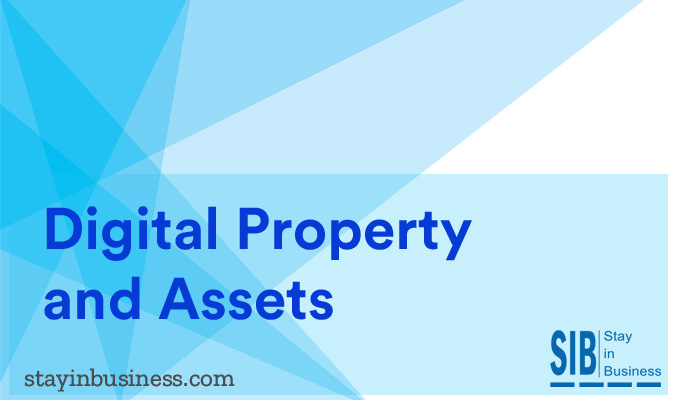
In today’s internet connected world, where everything is available at a click of a mouse, Digital Property and Assets
have become an important everyday word. So what exactly constitutes Digital Property and Assets? A loose definition of Digital Property and Assets would be any information or anything created by a person and existing in the digital form, available either in an electronic storage device or online, along with the information required to access such digital information, constitutes Digital Property and Assets.
Digital Property and Assets consists of three major categories and they are:
- Digital Property – personal
- Digital Property – personal with monetary value
- Digital Property – business
Digital property of a personal nature with no monetary value includes:
- Information stored in electronic format on platforms online, in the cloud, or storage device
- Online accounts such as e-mail, social media, shopping, photos and video sharing etc
- Domain names for personal use
- Intellectual property which has been created by or owned by you. This can include copyrighted material, trademarks etc
Digital property of a personal nature with monetary value includes:
- Computer software
- Websites/Blogs/E books/E Articles etc. which generate revenue
- Art, music, photos, videos etc
- Accounts used to manage money transactions such as Bank accounts, PayPal accounts etc
- Domain names
Digital property of a business includes:
- Digital property owned by a business organization
- Online accounts including banks, financial institutions, PayPal etc. which are registered in the business’s name
- Assets belonging to a business which are online such as an online store through which the business conducts sales
- Mailing lists, subscription lists, e-newsletters, e-books etc
- Client information
The above lists are not exhaustive but are only indicative. Digital Property and Assets comprises a vast sphere of items and a business needs to know exactly what its Digital Property and Assets are. Once a business knows exactly what its Digital Property and Assets are, then it can proceed to safeguard them from any disaster by including them in a Disaster Recovery (DR) plan.
One of the basic precautions a business should take is to always have back-ups of Digital Property and Assets. Ideally, the back-ups should be stored in a remote geographical location in physical or electronic form. If the Digital Property and Assets is stored in the cloud, then the business should do due diligence to find out how the cloud service provider takes back-ups and at what intervals.
All Digital Property and Assets stored in any electronic format should be password protected. The password should be known only those authorized to do so and the password should be changed at frequent intervals. If, for any reason, a third party has to be given the password for access, then as soon as the need is over, the password must be changed.
Personal assets that are password protected may be lost if the owner is incapacitated or deceased. As a part of proper management of digital assets, clear succession plans and authority to invoke them must be given to beneficiaries.
Digital Property and Copyright
Most Digital Property and Assets are protected by the copyright act. It is an automatic right and the business does not need to register their ownership. Usually the copyright holder is recognized as the first person who owned or created an asset, unless it was done so while in employment. In such cases, the copyright vests with the employer.
Protecting Digital Property and Assets
Though the law grants the copyright to the first owner or creator automatically, at times it can be difficult to prove. There are ways to protect Digital Property and Assets from misuse. Some of the common methods are:
- Show that the business owns the digital property by including the Copyright Symbol © or by including a declaration of copyright ownership
- Include a comprehensive statement warning that “All rights are reserved and no part may be reproduced without permission”
- A business can also digitally protect its assets by encryption, encoding or putting a watermark. This is especially useful for Digital Property and Assets pertaining to digital visual media
Owning Digital Property and Assets is a valuable ownership right. However, a prudent business will not only take necessary steps to protect them from a disaster, but also prevent its copyright being breeched or pirated.




